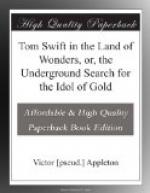“No?”
“No. Mary told him he’d better hurry along to Central America, or wherever it was he intended going, as she didn’t care for him as much as he flattered himself she did.”
“Good!” cried Ned. “Shake, old man. I’m glad!”
They shook hands.
“Well, what’s the matter? Didn’t you read all of her letter?” asked Ned when he saw his chum once more perusing the epistle.
“No. There’s a postscript here.
“`Sorry I couldn’t see you before you left. It was a mistake, but when you come back——’
“Oh, that part isn’t any of your affair!” and, blushing under his tan, Tom thrust the letter into his pocket and strode away, while Ned laughed happily.
With the idol of gold safe in their possession, Professor Bumper’s party could devote their time to making other explorations in the buried city. This they did, as is testified to by a long list of books and magazine articles since turned out by the scientist, dealing strictly with archaeo-logical subjects, touching on the ancient Mayan race and its civilization, with particular reference to their system of computing time.
Professor Beecher, young and foolish, would not consent to delve into the riches of the ancient city, being too much chagrined over the loss of the idol. It seems he had really promised to give a part of it to Mary Nestor. But he never got the chance.
His colleagues, after their first disappointment at being beaten, joined forces with Professor Bumper in exploring the old city, and made many valuable discoveries.
In one point Professor Bumper had done his rival an injustice. That was in thinking Professor Beecher was responsible for the treachery of Jacinto. That was due to the plotter’s own work. It was true that Professor Beecher had tentatively engaged Jacinto, and had sent word to him to keep other explorers away from the vicinity of the ancient city if possible; but Jacinto, who did not return Professor Bumper’s money, as he had promised, had acted treacherously in order to enrich himself. Professor Beecher had nothing to do with that, nor had he with the taking of the map, as has been seen, the loss of which, after all, was a blessing in disguise, for Kurzon would never have been located by following the directions given there, as it was very inaccurate.
In another point it was demonstrated that the old documents were at fault. This was in reference to the golden idol having been overthrown and another set up in its place, an act which had caused the destruction of Kurzon.
It is true that the city was destroyed, or rather, buried, but this catastrophe was probably brought about by an earthquake. And another great idol, one of clay, was found, perhaps a rival of Quitzel, but it was this clay image which was thrown down and broken, and not the golden one.
Perhaps an effort had been made, just before the burying of the city, to change idols and the system of worship, but Quitzel seemed to have held his own. The old manuscripts were not very reliable, it was found, except in general.




